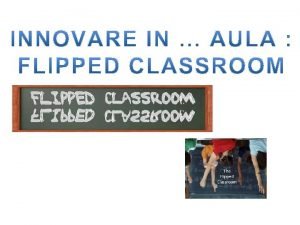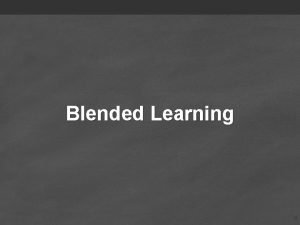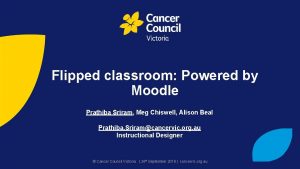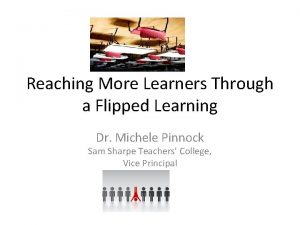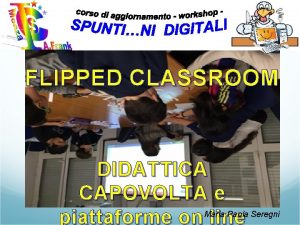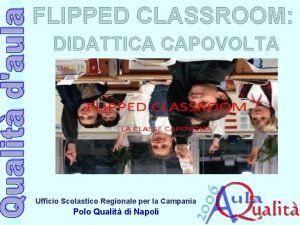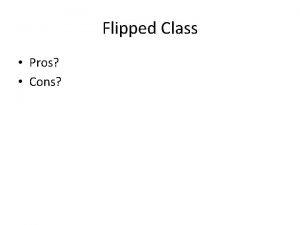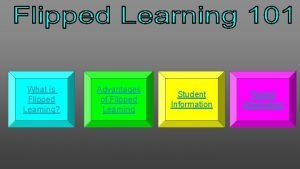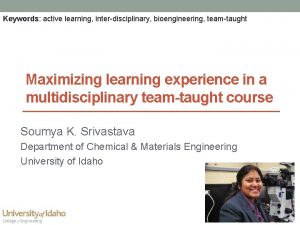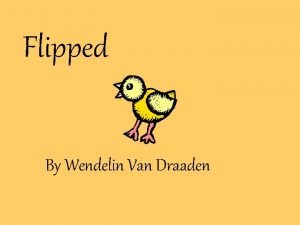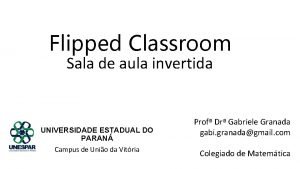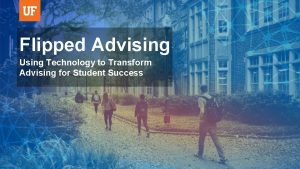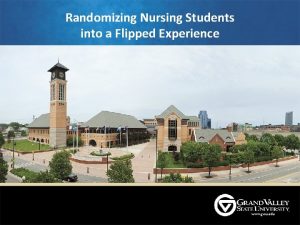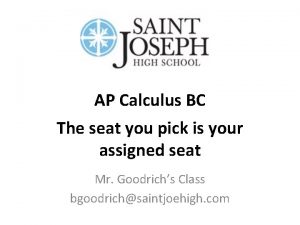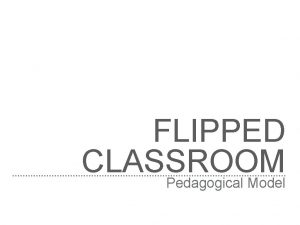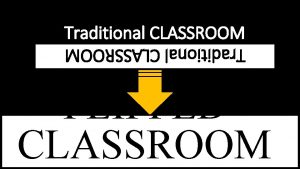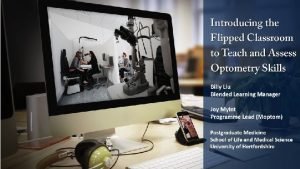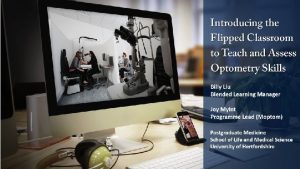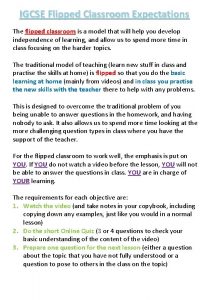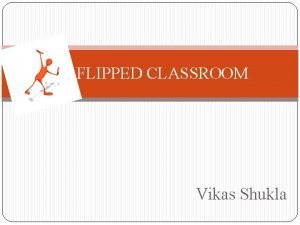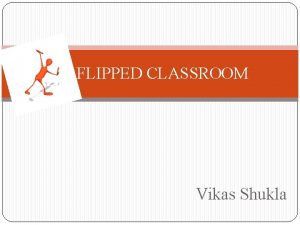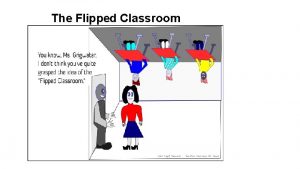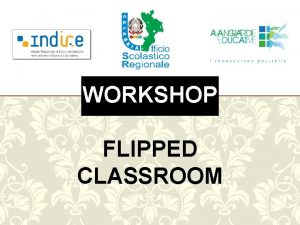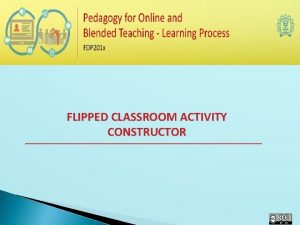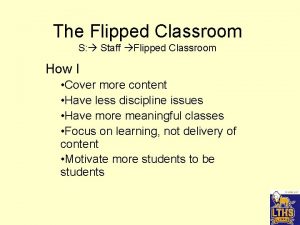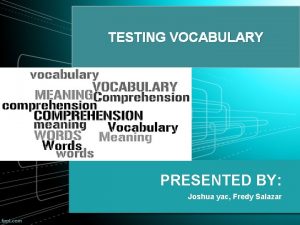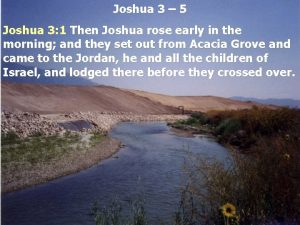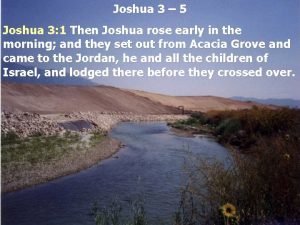Joshua Yac The flipped classroom is a pedagogical

















- Slides: 17

Joshua Yac

§ The flipped classroom is a pedagogical model in which the typical lecture and homework elements of a course are reversed. § It is a teaching strategy that allows instructors to more actively engage with students in the classroom.

§ In a traditional lecture, students often try to capture what is being said at the instant the speaker says it. § They cannot stop to reflect upon what is being said, and they may miss significant points because they are trying to transcribe the instructor’s words. § That is why the flipped classroom was created.

§ Harvard professor Eric Mazur played a significant role in the development of concepts. He found that information transfer out of the classroom and information assimilation into the classroom, allowed him to coach students in their learning instead of lecture. § In 1993, Alison King published "From Sage on the Stage to Guide on the Side" In the article, King focuses on the importance of the use of class time for the construction of meaning rather than information transmission. § Lage, Platt and Treglia published a paper entitled "Inverting the Classroom: A Gateway to Creating an Inclusive Learning Environment" (2000), which discusses their research on flipped classrooms at the college level. § Salman Khan in 2004 began recording videos at the request of a younger cousin he was tutoring because she felt that recorded lessons would let her skip segments she had mastered and replay parts that were troubling her.

§ Teacher teaches students inside the classroom § Students have to do their homework at home. § The teacher is typically the central focus of a lesson § Disadvantages. § Not all students learn at the same speed. § Not all students learn in the same way. § Class always looks the same

§ Students acquire knowledge before the classroom § Students does classroom activities in class. § The flipped model puts more of the responsibility for learning on the shoulders of students while giving them greater impetus to experiment. § What the flip does particularly well is to bring about a distinctive shift in priorities— from merely covering material to working toward mastery of it. § Learner centered

§ There is no single model for the flipped classroom. 1. The knowledge piece is done at home. § Short video lectures are viewed by students at home before the class session, while in-class time is devoted to exercises, projects, or discussions. § Online quizzes or activities can be completed at home. 2. Activities are done in class § Instructors might lead in-class discussions or turn the classroom into a studio where students create, collaborate, and put into practice what they learned from the lectures they view outside class. § It is doing active learning exercises and direct engagement with students *The term is widely used to describe almost any class structure that provides prerecorded lectures followed by in-class exercises.


§ All type of multimedia (shareable media) § Videos, podcasts, presentations. § Online testing

§ Advantages: § Students are engaged § Learning is more personal § Students can replay de media if not understood the first time. (keeping up with the class is no longer an issue). § Class time can be spent on class activities so students can apply the knowledge they received. § Media is portable and students/teachers can use it at any time. § Cooperative learning is applied (Students can get help from students that understood more). § Students becomes a self learner and problem solver.

§ The in-class activities involve a significant amount of quizzing, problem solving and other active learning activities, forcing students to retrieve, apply, and/or extend the material learned outside of class. These activities should explicitly use, but not merely repeat, the material in the out-of- class work. § Students are provided with real-time feedback. § Completion of work outside class and participation in the in-class activities are worth a small but significant amount of student grades. There are clear expectations for students to complete out-of-class work and attend in-person meetings. § The in-class learning environments are highly structured and well-planned.

§ Make sure all students have access to the media. § Get flash drives, print, burn cd’s with content § Teach students how to use the media: § How to interact with the media. § How to get the main points § How to watch a video – Focused § Length of the material Matters! § Use short videos, short podcasts, all depends on students grades. § It is advisable to 1. 5 per grade level of your students. § Make sure they do the homework § Ask for notes, embed the media to online pages that you can keep record of which students to watch the media. Place evaluation media. § Keep it simple § Don’t try to make everything perfect (make effective content). § Start small, you can flip a lesson, a unit, a whole class.

§ In flipped classrooms, technology enables instructors to more actively engage with their students. This is typically accomplished by using in-class time for active learning exercises and out-of-class time for watching recorded lectures. § Flipped classrooms allow for an unprecedented level of interactivity and insight into student learning and performance. By moving passive learning experiences outside of class, professors are able to use in-class time to engage students in activities such as small group problem solving, peer grading, and experiential learning activities


https: //www. youtube. com/watch? v=UK 3 -Mi 9 JYC 0&nohtml 5=False

§ Origami, from ori meaning "folding", and kami meaning "paper" (kami changes to gami due to rendaku)) is the art of paper folding, which is often associated with Japanese culture. § In modern usage, the word "origami" is used as an inclusive term for all folding practices, regardless of their culture of origin. § The goal is to transform a flat sheet square of paper into a finished sculpture through folding and sculpting techniques. § Test: § What is origami?

http: //en. origamiclub. com/easy/animalface/fox/animefox/index. html
 Future of human genome project
Future of human genome project Yac
Yac Venitemi dietro con l'occhio
Venitemi dietro con l'occhio Flipped classroom
Flipped classroom Meg moodle
Meg moodle Flipped classroom examples
Flipped classroom examples Paola seregni
Paola seregni Flipped classroom schema
Flipped classroom schema Flipped classroom pros and cons
Flipped classroom pros and cons Flipped learning advantages and disadvantages
Flipped learning advantages and disadvantages Bioengineering flipped classroom
Bioengineering flipped classroom Btech smart classes
Btech smart classes Flipped sum of its parts
Flipped sum of its parts Setting of flipped
Setting of flipped Flipped roteiro
Flipped roteiro Flipped advising
Flipped advising Flipped
Flipped Flipped math calculus
Flipped math calculus


